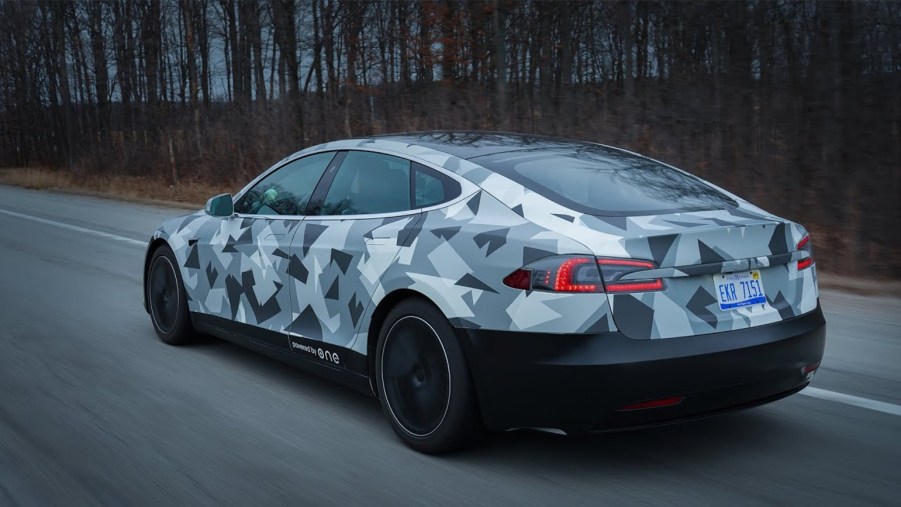
Tesla Model S Is a 750-Mile EV With ONE Gemini Battery Swap
Even as battery technology improves, range anxiety continues to worry potential EV owners. Though given the current state of EV infrastructure in the US, at least some of those worries are understandable. And it’s worth remembering that all batteries, even Tesla’s packs, lose capacity as they age. However, a Michigan-based startup might have just shown how to solve both issues in one fell swoop. Namely, by doubling a Tesla Model S’s range with a ONE Gemini battery swap.
The ONE Gemini battery offers EVs extra plug-and-play capacity without using cobalt

Even if you haven’t heard of ONE—or ‘Our New Energy,’ to give the Novi, Michigan startup its full name—you’ve likely felt some of its employees’ work. ONE’s CEO and founder, Mujeeb Ijaz, has over 30 years of experience in battery development gained at Ford and A123 Systems. He was also part of the original Apple Car team. And since founding ONE two years ago, he’s already received $25 million of funding from, among other entities, BMW.
The company’s most recent development is the ONE Gemini, a so-called dual battery pack. At first glance, it seems like a conventional lithium-ion EV battery pack. However, there’s far more to this pack than meets the eye. And buckle up because it’s about to get technical.
Firstly, there’s the ONE Gemini battery’s ‘dual’ nature. Think of it as two kinds of EV batteries in one easy-to-install package, The Drive explains. Like essentially all EVs, the ONE Gemini has a traction battery. This differs from a ‘conventional’ lead-acid car battery in that, rather than a short burst of power, it delivers power over a sustained period.
But while the traction portion is normal for EV batteries, the ONE Gemini’s second portion, the range-extender, isn’t. As of this writing, its structure is still in the experimental stage, MotorTrend reports. Nevertheless, as its name suggests, it basically acts as a built-in power bank for the traction battery. Picture the optional range-extending engine on a BMW i3, only a battery.
However, the ONE Gemini battery pack’s ‘dual’ nature isn’t its only novelty. Although it’s a lithium-ion pack, the traction portion uses lithium-iron-phosphate chemistry. This means it doesn’t require cobalt, a particularly problematic material. And it makes it cheaper than other kinds of lithium-ion batteries. Also, the Gemini’s range-extender portion doesn’t depend on nickel or graphite, high-demand materials seen in most other EV batteries.
A Tesla Model S Long Range Plus gets double the IRL range by swapping in a ONE Gemini battery prototype

As fascinating as the chemistry is, it’s the ONE Gemini battery pack’s structure that truly sets it apart. Because it’s sort of two batteries in one, it lets ONE pack more capacity into a particular space. Say, the same space as a Tesla Model S Long Range Plus’s standard battery.
As of this writing, the 2022 Tesla Model S Long Range Plus has the second-highest range of any production EV. With a 103.9-kWh pack, it can go a claimed 405 miles on a charge. And while its real-world range is noticeably lower, it still managed an impressive 320 miles in Car and Driver’s hands.
With the ONE Gemini battery, though, the Tesla Model S can outlast even the current range leader, the Lucid Air Dream Edition R. That’s because, instead of 103.9 kWh, the Gemini has a 203.7-kWh capacity. And with that extra capacity, the retrofitted Model S covered 752 miles on a mid-December Michigan road trip traveling 55 mph.
That 752-mile figure is particularly noteworthy given how cold temperatures suck away battery power. However, the ONE Gemini battery-equipped Tesla Model S did one better afterward. Strapped to a third party’s dynamometer for an EPA-style test, the EV went 882 miles on a charge at 55 mph, MT says.
In short, ONE more than doubled a Model S’s range with a battery swap.
Will this high-range EV battery actually go on sale?
As of this writing, ONE says the Gemini battery pack is still a proof-of-concept prototype. But it won’t be for long. The company plans to launch a production version sometime in 2023. And its other product, the lithium-iron-phosphate-based Aries, will enter production later this year, Car and Driver reports.
Admittedly, ‘sometime in 2023’ is a ways away. However, it’s worth noting that Tesla and Fisker have already invested in lithium-iron-phosphate battery tech for cost- and environment-related reasons. Furthermore, other OEMs are pursuing alternative lithium-ion batteries. For example, Toyota and its solid-state batteries. So, on a purely technical level, ONE’s ideas have significant merit.
And if the ONE Gemini battery can deliver on its prototype claims, range anxiety really might be a thing of the past.
Follow more updates from MotorBiscuit on our Facebook page.


